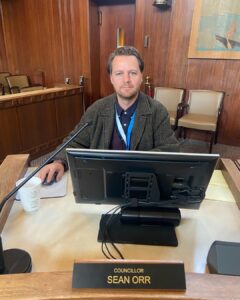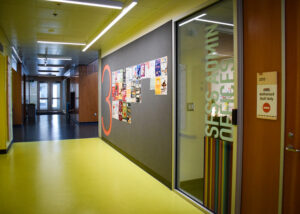| [dropcap]“[/dropcap][dropcap]C[/dropcap]ourse enrolment pisses me off. If seats are full we should have the option to either stand or bring our own stool to class,” read a recent comment posted on the SFU Confessions Facebook page. |
After 20 minutes, the comments had received 40 likes; after an hour it had over 100. By the next day, it had garnered almost 1,000 likes, making it one of the most popular comments on the group in the last while, by far.
The message conveys a distinct frustration that students experience while registering for courses each semester. In surveys, SFU undergraduates routinely report encountering full courses, scheduling conflicts, courses not offered frequently enough, students’ late scheduling dates, and courses reserved for other students. These frustrations have students — predominantly from the Arts and Social Sciences, the Faculty of Communication, Art and Technology, and the Beedie School of Business — pulling their hair out in anger.
“The course selection process is extremely difficult and frustrating,” claimed third year Criminology major Yvonne Hanson in a video by The Peak. “I’ve been struggling with it the whole time. If you haven’t declared your major yet, you can’t get into any classes you need. So you wind up with the most bullshit little courses.”
“I had a horrible time with enrolment this year,” said second year IAT and Business major Gabriel Yeung. “I wasn’t able to get into most of my [IAT] major courses [. . .] I tried for eight courses, and I didn’t get into them. Now I’ve ended up with a semester of electives.”
“When I get [an enrolment] date I can already tell that I’m going to have a disadvantage,” responded yet another student. “I’m looking at the availability of courses, and then once my [enrolment date] reaches, the majority of them are already closed.”
These negative sentiments are reiterated in last year’s SFU Undergraduate Survey “course availability” section. Popular comments including “offer more courses,” and “better class availability,” further confirm student frustrations.
Issues with course enrolment have affected SFU students for years, as indicated in the 1998 Undergraduate Student Survey highlights, which convey that only 60 per cent of undergraduates were able to register for the courses they wanted. Since then, student satisfaction with registration in the courses they want to complete their degree has not improved. In Fall 2005, only 56 per cent could enrol in the courses that interested them; in 2008, it was 54 per cent; most recently, in 2014, it was 58 per cent.
Furthermore, in 2005, just over half (53 per cent) of the undergrad population found they were taking longer than expected to complete their degrees — a number that hovered around 57 per cent until 2013, before jumping to 64 per cent in 2014.
SFU’s 2010 Degree Completion Experience Survey shows that students complete their degrees on average 2.1 years past the traditional four-year time frame, a number which must come as a surprise to the 70 per cent of students in the same survey, who said they expected to complete their education in explicitly four years, and the 85 per cent from the Fall 2013 Undergraduate Student Survey who claimed graduating within their expected timeframe is important.
SFU’s Institutional Research and Planning (IRP) office conducts an annual undergraduate student satisfaction survey to “provid[e] essential feedback on academic experiences and concerns,” which usually garners a 20 to 30 per cent student response rate. They also prepared a variety of in-depth studies specifically into resolving course availability issues from 2007 to 2011.
The 2007 study states on its first page that “SFU’s course availability has been deteriorating,” and that “compared with other British Columbia universities, students at SFU experience considerably more problems with course availability and timely degree completion.” And despite several reports, surveys, and recommendations, the statistics in student satisfaction have more or less remained the same since the first online report was posted in 1998.
Many students at SFU clearly have trouble enrolling in many of the courses they want — an issue that is caused by multiple facets of the university system, and which could ultimately increase student attrition rates and damage the school’s reputation.
| [dropcap]“[/dropcap][dropcap]W[/dropcap]e’re working on it,” Gordon Meyers, SFU’s Associate Vice President Academic, explained in regards to students’ enrolment concerns. “We know that course access is a serious issue.” |
Meyers directly oversees all enrolment planning at SFU, and keeps in contact with SFU’s IRP office for patterns in course access research findings. He sits on a Senate Committee for Strategic Enrolment Management — which reports to SFU’s Senate with findings and proposals regarding course registration.
SFU’s course registration issues are caused by a variety of interconnected problems, all of which are related first and foremost to the ever-looming budgetary constraints that every university faces.
Meyers mentioned that once government funding (which decreased another two per cent for the 2015 fiscal year) has made its way to SFU, the money is then dispersed among the faculties in accordance with how many enrolments each faculty receives.
“It’s a student-centred budget,” stated Meyers. “If a faculty gets more students choosing courses from that faculty, they’ll receive a bigger budget [. . .] This gives [faculties] the resources to solve course access problems because it gives them the money to put on those extra courses.”
The problem seems to lie not in the allocation of government funding but an overall lack of it. In fact, the most recent five-year academic plan Faculty of Arts and Social Sciences states as one of its weaknesses that “insufficient base funding has [. . .] created significant and sustained losses in research expertise in a number of our departments and schools” and that “these losses threaten the quality of [its] undergraduate programs, [. . .] graduate programs and [. . .] international reputation.
| [dropcap]A[/dropcap]major factor contributing to SFU’s budgetary constraints is its unique trimester system, a way of operating that Meyers acknowledges is more expensive than the traditional semester system, but one that is not without benefits. |
“The trimester system was [established] so that we’d use our buildings for the full year, and we can therefore save resources,” Meyers explained. “We don’t need as many buildings to educate the same number of students if we’re running all year round. It also provides additional flexibility for students, for example you can start any semester.”
While these factors have merit, SFU’s trimester system was mired in controversy from its very origins.
Hugh Johnston details, in his 2005 book Radical Campus, that during the university’s construction, higher-education was being given an infusion of public money while members of the public and politicians alike criticized universities for expecting this increased funding and yet operating only on a semesterly (fall and spring) basis.
“The course selection process is extremely difficult and frustrating.”
— Yvonne Hanson, 3rd Year Student
While university presidents tried to explain that summers were coveted by professors to keep their research current, SFU delegated academic planner Ron Baker — who would soon grow to dislike teaching within the trimester system himself — to examine the question of whether or not to open the school year-round.
According to Johnston, while extensive evidence from American universities proclaimed a year-round system to be more expensive than the traditional route, Baker hurriedly calculated SFU would save costs within the trimester system. Radical Campus conveys that “after the university had been running for a few years, [Baker] could see that the savings were not there,” and in fact “[by] 1972 a management consultant firm calculated that the trimester system was costing SFU an extra 19 per cent per full-time student.” But by this time the system was so ingrained in the school’s culture that the administration “expect[ed] that SFU would lose students without it.”
Back when the trimester system was implemented, the idea was that schools operating year-round would be more deserving of additional government funding, but SFU is given more or less the same amount as its comparator universities who operate on a traditional academic calendar.
SFU received a grand total of $293.5 million in government funding for its roughly 35,000 students in 2015, around $8,400 per student. Similarly-sized schools such as Ryerson received a close-figured $7,500 per student, while the University of Victoria, a smaller school, received roughly $12,250 per student.
This means that while students at UVic or Ryerson have access to all academic resources during the fall and spring semesters, many students at SFU — especially the 35 per cent who currently attend the school only during the fall and spring semesters — do not have access to the school’s full range of resources during these periods. The significant difference is stretched over to operate the third semester while keeping all expensive facilities fully operative.
Johnston also states that Baker incorrectly assumed the trimester system’s advantages for students, as “he calculated a decided financial gain for students heading into professional careers if they decided to forgo summer jobs so they could start their careers a year earlier.” Johnston suggests that taking three full course loads per year isn’t practical for most students, who take part-time jobs to support themselves while in school.
As it stands today, a significant population of students work part-time while attending SFU. According to the Fall 2015 undergraduate enrolment report, SFU enrolled 13,160 full-time undergraduates along with a striking 12,161 part-time. Moreover, the previous summer semester saw 4,163 full-timers dwarfed by over 12,000 part-timers.
The Canadian University Survey Consortium (CUSC) states that 37 per cent of SFU’s first-year students in 2013 worked off-campus while attending school as compared with the average 25 per cent from comparator universities, while middle-years from 2014 and graduates from 2015 work 46 and 49 per cent respectively, compared with the 40 and 41 per cent comparator averages. Hence, there are more undergraduates at SFU who are employed while completing their educations, than there are at any comparator universities.
While SFU may provide educational flexibility for students who work part-time, the trimester system may actually be influencing students to find a means to finance their own education while they attend school.
SFU’s 2010 Degree Completion Experience Survey confirms one third of delayed graduates actually reduced their course load because of course availability issues, and not because of part-time work, thus prolonging a degree that becomes more expensive as the trimesters add up.
As such, SFU’s administration faces difficulties of scheduling classes in accordance with the times students are available and not at work, thus further limiting the quality and diversity of course options during registration.
This is especially tough for students interested in co-op, and frustrates their schedules further if they choose a co-op term that conflicts with preferred or required courses. Difficulties also arise for students who have yet to declare a major, and thus aren’t given priority registration dates.
The trimester system is uncommon in Canada, and in addition to SFU, has only been adopted by the University of Waterloo and the Université du Québec.
| [dropcap]W[/dropcap]hen it was adopted, the trimester system was supposed to use classroom space more efficiently than a semester system since the university was in operation year-round. But not only has the overall growth of enrolment at SFU outpaced the creation of teaching space, the year-round system causes special problems for building maintenance. |
According to Rella Ng, the Associate Registrar at SFU, spatial constraints play a large factor in whether or not courses are offered. Ng works at Student Services and makes sure that the course schedules submitted by the faculties can be properly implemented into the scheduling system in a way that allows for the class capacities to be assigned to the appropriate rooms on campus.
“We only have a certain number of large classrooms and theatres,” Ng said.
Ng is not the only SFU employee to vocalize spatial problems. Aoife Mac Namara, Dean of the Faculty of Communications, Art and Technology (FCAT), expressed her concerns that “probably the biggest resource we don’t have is space. So even if we had 10 faculties and whoever to teach the course, there wouldn’t be any room for it.”
SFU has also grown in population over the past few years, and the school’s most recent five-year Capital Plan released last year indicates that total full-time undergraduate enrolment “has grown by 59% during the period from 2001/02 – 2012/13,” and that “space inventory during this time has not kept pace, increasing by only approximately 47%.”
Moreover, Beedie School of Business’s 5-year academic plan states as one of its current “threats,” that “space limitations across all three campuses compromise the effective delivery of undergraduate and graduate business programs, and future program opportunities.”
SFU is especially struggling to accommodate the exponential student growth at its Surrey Campus which places further constraints on courses offered due to increased competition at this location.
“Surrey’s [full-time enrolment] (FTE) is over capacity by a long shot,” explained Elizabeth Starr, development planner at SFU Facilities and Services, and co-writer of the five-year Capital Plan. “FTE capacity in Surrey is 2500 [. . .] And we know we’re incredibly under-serviced in Surrey.”
SFU’s most recent Surrey enrolment report confirms that FTE enrolment for Fall 2015 was at 3,380 — placing SFU Surrey’s population at 35 per cent over capacity. Currently, SFU plans to expand the Surrey campus to allow for 5,000 FTE students, but this project has yet to be officially approved.
In addition to spatial constraints, SFU also has maintenance problems which affect the number of course offerings. As an associate registrar, Ng said she “quite often” removes classes from the registration system entirely, due to the abundance of deferred maintenance issues plaguing this half-century old university.
The five-year plan states that out of SFU Burnaby’s 35 academic buildings, only 10 are in “good” condition, while 13 are in “fair,” and 12 are labelled as “poor.” Because of this, the Plan has made restoring the school a priority.
Ng said that because there are fewer courses offered during the summer, SFU can make efficient use of this time to take classrooms offline in order to make the necessary repairs, but many times this isn’t the case.
“In Fall and Spring we get calls from Campus Planning and Facilities who say, ‘this room needs to be taken offline because it’s leaking,’” Ng explained. “Then we struggle to find [new] classrooms, and sometimes we [visit the departments] to discuss moving these classes around.”
SFU relies on government funding for the major maintenance repairs it needs and while it would take an estimated $532 million to make all the necessary upgrades to SFU Burnaby’s “poor condition” buildings, in an email, Associate Vice-President of Finance, Alison Blair, stated only “$3.9 million [was given] earlier this year, and $3.3 million more recently.”
Mac Namara does claim that a “big deferred maintenance [deposit]” from the provincial government is likely heading toward SFU, which “will be the first in line given the state of [the] facility.” An email message from the Associate VP Academic did not indulge in the rumour, stating that while there are “indications that the sector will receive additional deferred maintenance funds [. . .] there is currently no certainty.”
“We know that course access is a serious issue.”
— Gordon Meyers, Associate Vice
President Academic
| [dropcap]D[/dropcap]espite the web of interconnected systemic factors contributing to SFU’s less-than-satisfactory course enrolment system, the Dean of FCAT feels that the issue really isn’t that difficult to solve, just one that requires a culture change in student course planning advising. |
Mac Namara stated that FCAT’s course enrolment is the top priority issue she’s currently working to resolve, and that she has a three-pronged plan.
The first prong is to have the university uniformly understand what constitutes a full course load. SFU currently labels a minimum of nine credits (three courses) as “full time,” a number which MacNamara alludes is too low.
“What I hear all the time is that students can take only three [courses] because the workload is too high, and that shouldn’t be the case [. . .] Ideally, we should be able to tell students that if you come and do a full course load the whole way through, then you should be able to finish [a degree] in four years or five with co-op [. . .] When you don’t have a full course load it’s much harder to predict how many people are going through at what time.”
“The first thing we need to look at is what workload is involved in our courses, and then we need to ask students and advisors why we keep encouraging people to take fewer courses.”
The second prong would require first-year students to sit with an advisor and fill out a planning sheet for their entire four to five-year degrees. This will force them to understand from the beginning that there’s a relationship from one course to another, which will give them a better understanding of the hurdle-prerequisites they’ll have to meet to take what they’re really interested in.
Mac Namara believes that “there has to be a social contract between the students and the administration [stating] that we’ll both work together to help the student progress in a timely way.”
The third prong is to construct better networks between the advisors and different faculties in order to broaden faculty knowledge of similar course offerings.
“For example, if you wanted to do a course and it got cancelled there [will] often [be] courses [in other faculties] that are similar,” she explained in reference to better networks. “[They probably won’t be] the same — but they might give you something from another faculty [to substitute].”
Executive Mark Roman, who took his position as SFU’s Chief Information Officer (CIO) in September 2015, echoes Mac Namara’s notion of strengthening administrative relations, and reveals that there is large disconnect between the faculties. Each currently uses their own computer systems to plan and manage only their sectors.
“For example, Beedie School of Business has a system called Tracs, which [allows] them to see the faculty visually, to see what course they’re teaching and in what term, and they can start to plan for faculty workload.
There’s a number of systems out there and they’re all different [. . .] Once faculties receive a system they have to change large percentages of the system’s code to adapt to their own particular needs.”
Roman currently has a vision for “one Information System” in that SFU’s systems behave cohesively and the people work more collaboratively. He relays that SFU will soon be receiving $75 million dollars from the Canadian government to set up one of Canada’s four high computing data centers.
Integrating SFU into one system will take at least a couple of years, but Roman hopes that a unified information system will allow the administration to work cohesively, and that SFU “can start to do more integrative planning with (this) data” in terms of not only smoothing out course access issues, but all facets of administrative systems.
| [dropcap]G[/dropcap]ordon Meyers, along with Rummana Khan Hemani, Director of Student Success and Strategic Support who also sits on a Senate Committee for Strategic Enrolment Management, are also reportedly attempting to determine ways to improve course access and are “constantly looking at survey data” from the IRP office. |
“We look at which classes are full at the end of week one during class registration [and] one of the first things Rummana and I did was we simply sent a list of courses that were full to the deans and associate deans to have them tell us what the deal was,” said Meyers.
Meyers said that through the process of relaying course statistics to the faculties, they feel they’ve recently noticed some improvements in course registration data.
“[We’re] leading a joint project where we’re studying the question of course access,” Meyers continued. “A year ago, the former registrar and I went to talk to the Chairs and Directors, and asked them questions. [Because] we got some sense in the last couple years that things have been improving [. . .] we’ve decided to sit down and see if that’s actually correct by doing another study, rather than just being satisfied with the one from five years ago.”
This study reportedly involves a new data capture method.
Hemani stated that along with examining course enrolment data from students with undeclared majors in order to better understand what students are interested in, Student Services has begun to capture data from students’ course planners, located on the Student Information System, which allows students to place potential courses in lists for future semesters, as a means of helping them plan their degrees.
Hemani said, “Students are actually starting to tell us through the system [. . .] ‘well I want to take this in the Spring [for example].’ [. . .] We’re not using the data right now, but we’re starting to capture it. There’s a lot more I think we can do just through mining our own data and actually using it a bit more effectively. We have the capacity now with the system to do that sort of thing. It’s just [a matter of] figuring out the best way to do it.”
“What I hear all the time is that students can take only three courses because the workload is too high, and that shouldn’t be the case.”
— Aoife Mac Namara, Dean of FCAT
| [dropcap]O[/dropcap]ne of the most prominent challenges SFU’s administration currently faces lies hidden behind the obstacles of the trimester system — it’s difficult to learn, analyze and provide resources for student educational preferences when courses are selected on a term by term basis. |
At a university with a two-semester system — such as UBC — students plan and lock-in their courses a year in advance, which allows the institution to effectively schedule and resource those courses, and to predict future course offerings, thus leaving students far more satisfied overall.
SFU does not currently have this advantage and is left navigating other less concrete or effective routes to understanding what students want. To further complicate matters, it could be said that many SFU students themselves don’t exactly know what they want because they have no idea when their preferred classes will be scheduled, thus further influencing constant switching and dropping of courses — combine this with part-time employment, and SFU is left with a steady cycle of confusion, frustration, and inefficient planning.
Hemani indicated the possibility that administration would consider allowing students to schedule two or three semesters in advance.
“We’ve talked about it a number of times [. . .] Departments are actually scheduling a year in advance. They know what to offer, and they adjust and adapt [. . .] But what is preventing us from allowing students to enroll for the year? I don’t know the answer to that. It’s an important perspective, and we can probably start to gather that information from students in terms of asking whether that would be helpful.”
But what if SFU were to rid itself of the trimester system entirely to potentially alleviate many of SFU’s problems including course enrolment frustrations?
“My personal view is that [the trimester system] is likely something that needs a study to know whether it’s a smart idea or not,” said Meyers. “I hear discussion about it with the faculties, but the building thing is big and there is a loss of flexibility. People don’t really take a full course load so [a student] ends up taking more than four years. It’s been a long time — 50 years since we’ve adopted it.”
| [dropcap]T[/dropcap]he numerous studies that SFU’s IRP has conducted over the last decade or so clearly indicate that this university has long had a major course availability problem that threatens the integrity and efficiency of the institution. |
This university seems to be an anomaly within a society that has distinct cultural and financial expectations when it comes to post-secondary education. A trimester education, as opposed to the semesterly one, defies the cultural standard, inconveniences students, and ultimately burdens the administration — a notion enhanced by the fact that SFU only allows its students to pick courses one semester in advance.
It might be best for this university to consider switching to a semester system, which would ultimately save resources, provide students with access to more courses and professors, and provide the institution with concrete knowledge on students’ preferences.
Structurally, SFU’s internal operations could indeed run more efficiently. As Dean Mac Namara expressed, faculties should consider establishing consistent, detailed communication with each other and the rest of SFU regarding what they’re doing to improve courses access within their faculties and departments. Faculties could further be encouraged to make publicly transparent their actions; while many of the faculties cite course access improvements in their academic plans published every five years, perhaps preparing a yearly public report on course access improvements within their sector would further enlighten and ensure the public that actions are being taken.
In the short term, it may be in students’ best interests to login to the SIS and add prospective classes to their course planners. If SFU is truly beginning to capture and analyze this data, then apart from visiting an advisor directly, this could prove a useful option to help administration. Conversely, SFU could seriously consider allowing students to enrol multiple semesters in advance, given that departments are reportedly churning out their schedules as such.
While it may be perceived to have taken far too long, it’s refreshing to see that the Executive has this complex problem on its priority list, and perhaps if SFU’s developing system technology proves itself, as Hemani expressed, progress just may move at a swifter pace.
Therefore, in order to capture the data they need, the executive should increase their efforts to encourage the faculties and departments to make the SIS course planner more transparent. Additionally, executives should make their specific actions and progress more transparent altogether — perhaps through more frequent meetings and reports from the Senate Committee on Enrolment Management and Planning.
And in order for the school to establish much-needed consistent relationships with students, the executive should expand departmental advising staff, and request that advisors work longer hours during the high-demand periods of the semester, as the current FCAT five-year academic plan cites “inadequate advising” as one of its internal weaknesses.
In the end, communication and understanding is key; the Faculty of Arts and Social Sciences has transparently recognized in its academic plan that it has “been largely ineffective in communicating its [. . .] needs to develop an effective communication strategy with clear goals for success,” and that “inadequate [. . .] communication with Student Services has resulted in errors and frustration for students and advisors.” Because course access is a such a multi-faceted issue, it’s crucial that all components of the administration, and the students alike, work together to improve the student experience as much as possible within the unique constraints of this institution.
If we continue to make academic life as much of an inconvenience, then SFU will continue to be a dissatisfied ‘radical campus.’














Maybe SFU should first promote first year students to take their first year at a community college, perhaps even stop offering first year courses all together. This would alleviate a fourth of the space and faculty. Also they could simply offer online courses for any course that can be an online one, so motivated students could finish the courses they desire when they desire it.
Hopefully they will work this out soon enough.
This is ridiculous and frustrating to say the least! I am in my 3rd year at SFU trying to finish my degree online. I have one course to choose from out of the 17 required right now.. something definetaly needs to be done about this.
[…] I had nobody and I did it to myself. If you lose the class code before you add yourself to the class, ask your teacher for the code again. Your login information does not get reset from term to term. I always cover my face and walk as quick as I could .everyone thinks so low of melike I’m quiet and shy and ”I cannot talk”.When I say something people say check my site […]